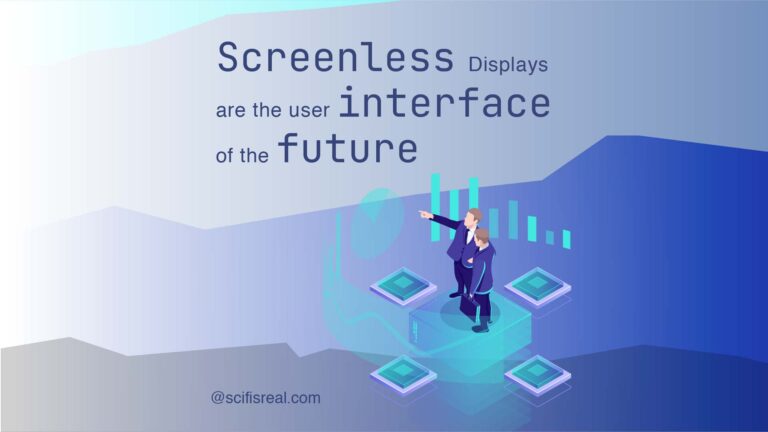Screenless Displays are the user interface of the future

The emergence of Screenless Displays technology has enabled sci-fi movies to become a reality, pushing the boundaries of what was thought possible in the field of human machine interfaces. This exciting new technology uses unique display systems that do not require any physical screens or projections; instead, users can interact with their devices through various means of sensory input. This creates an entirely new level of interaction that was not previously possible and promises to revolutionize how humans interact with technology in their everyday lives. With the rise of Screenless Displays, sci-fi films have become even more realistic, as users can now find themselves immersed in a sci-fi world without the need for physical screens. By using this innovative technology, sci-fi filmmakers have the potential to create a whole new level of storytelling in the movies they produce. Screenless Displays may be the key to unlocking a sci-fi world that was once thought impossible.
How soon until Screenless Displays hit the markets?
Advancements in technology are now being made at a rapid pace. According to market research reports:
“The global screenless display market was valued at $1.9 billion in 2020 and is projected to reach $14.9 billion by 2030, growing at a CAGR of 23% from 2021 to 2030.”
Many of the components that contribute to Screenless Displays have already been developed, such as Visual Image Display, Holographic Display and Heads Up Display, and Touch Screen Technology. On top of that, scientists are researching further into Retinal Displays and Synaptic Interfaces, which may eventually lead to the development of a Screenless Computer and Monitor. Ultimately, this technology is quickly evolving and it won’t be long until users are able to experience a truly immersive user interface with enhanced visuals and interactive capabilities.
As the technology continues to evolve, Screenless Displays will become even more prevalent in everyday life. This technology promises to revolutionize the way we interact with technology and could provide a gateway into an entirely new realm of entertainment, such as playing video games, watching films or browsing the web. In addition to enhancing user experience, Screenless Displays offers users the potential to explore new ways of interacting with their environment through Holograms and other transmission of visual data.
The possibilities are endless when it comes to Screenless Displays, as this rapidly evolving technology continues to push the boundaries of what was thought possible in the field of human-machine interface. With further research and development in the area, users could soon be immersed in a futuristic world without the need for physical screens. As sci-fi films continue to become more realistic, Virtual Interfaces could be the game-changer that revolutionizes how we interact with technology in the future.
Screenless Display interface technology seen in Sci-Fi movies
1. Minority Report (2002)
Directed by Steven Spielberg, this sci-fi thriller is set in 2054 and follows protagonist John Anderton as he attempts to stop a group of ‘precogs’ from predicting a murder that he is accused of committing. This movie features an extensive range of screenless displays, ranging from gesture control to voice recognition and haptic feedback.
2. Ready Player One (2018)
Director Steven Spielberg’s sci-fi action adventure movie is set in 2045 and follows protagonist Wade Watts as he searches for a hidden Easter egg inside a virtual reality game while attempting to win control of the world’s most powerful company. This movie features a variety of screenless displays, such as gesture control, eye tracking and haptic feedback.
3. Elysium (2013)
This sci-fi action thriller is set in 2154 and follows protagonist Max Da Costa as he attempts to save himself from a terminal illness by reaching the space station Elysium. In this movie, screenless displays are used extensively for controlling the movement of armatures, as well as providing real-time data on the station’s inhabitants.
4. Ex Machina (2015)
This sci-fi drama follows protagonist Caleb Smith as he attempts to test the artificial intelligence of robot Kyoko. In this movie, screenless displays are used to control the movements of robotic arms, as well as providing data on the AI’s thought processes.
5. Blade Runner (1982)
This sci-fi noir is set in 2019 and follows protagonist Rick Deckard as he attempts to track down a group of rogue replicants. In this movie, screenless displays are used for creating holographic images and controlling the movements of robots.
What are the types of Screenless Display interfaces?
Visual Image Displays
This type of display utilizes light-emitting diodes (LEDs) and miniature projectors to create various images in the air. These images can be used for interactive purposes, such as pointing, selecting and manipulating on-screen objects.
Holographic Displays
This type of display utilizes laser technology to create three-dimensional holograms that can be manipulated and interacted with in real time. This is particularly useful for providing detailed information about objects, as well as creating immersive virtual reality experiences.
Retinal Displays
This type of display utilizes lasers to project images directly onto the retina, allowing users to view digital content with their eyes. This is especially useful for providing a unique viewing experience and eliminating the need for physical screens.
The technology behind Screenless Displays
Eye-Tracking technology in Screenless Displays: This type of display utilizes infrared cameras to detect and track the eye movements of users, allowing them to control on-screen objects without physical touch. This is especially useful for providing precise input in gaming applications, as well as helping with accessibility.
Audio User Interface in Screenless Displays: This type of display utilizes sound waves to provide auditory feedback that can be heard by users. This is particularly useful for providing information about interactions or providing navigational guidance, as it eliminates the need for a physical screen.
Infrared Gesture Recognition in Screenless Displays: This type of display utilizes infrared motion sensors to detect body movements and gestures made by users. This is especially useful for controlling devices from a distance, as well as providing an intuitive way of interacting with on-screen objects without physical contact.
Voice User Interface in Screenless Displays: This type of display utilizes voice recognition software to communicate with users and understand their commands. This is especially useful for applications where hands-free interaction is preferred, as it eliminates the need for physical touchscreens or buttons.
Haptic Technology in Screenless Displays: This type of display utilizes haptic feedback technology to create tactile sensations that can be felt by the user. This is particularly useful for providing feedback about interactions, such as when pressing a virtual button or moving an on-screen object.
Augmented Reality Displays: This type of display utilizes augmented reality (AR) technology to overlay digital images and graphics onto real-world environments. This is especially useful for providing detailed information about objects and locations, as well as enhancing the user’s experience of interacting with them.
Ultrasonic Displays: This type of display utilizes ultrasonic waves to provide haptic feedback that can be felt by users. This is particularly useful for providing tactile feedback about interactions, such as when pressing a virtual button or moving an on-screen object.
RFID Displays: This type of display utilizes RFID technology to detect and track the presence and movements of users in a certain area. This is especially useful for providing interactive experiences within virtual reality environments, as it allows users to move freely without having to touch any physical device.
Biometric Authentication in Screenless Displays: This type of display utilizes biometric authentication technology to securely identify users. This is particularly useful for applications where secure access is needed, as it eliminates the need for passwords or physical keys.
Applications for Screenless Display Interfaces – Gaming & Entertainment to Industrial Automation
The potential applications for Screenless Display interfaces are immense, from gaming and entertainment to industrial automation. The sci-fi genre has been one of the key drivers for this emerging technology, as sci-fi filmmakers have a unique opportunity to create new user experiences that were not previously possible. Additionally, Screenless Displays can be used in many different industries ranging from automotive to medical care where increased efficiency is desired. By making use of this innovative technology, sci-fi filmmakers and technologists alike can open the door to a sci-fi world full of possibilities.
As Screenless Display technology continues to develop, the future is sure to be filled with exciting new possibilities and applications for this innovative technology. From interactive gaming experiences to improved industrial automation, Screenless Displays are sure to revolutionize how humans interact with their environment in a variety of different ways. The sci-fi genre may have been one of the first to explore this technology, but it will be interesting to see how other industries make use of Screenless Displays in the future. With the potential for increased efficiency and improved user experiences, Screenless Displays are sure to be a major part of our lives in the years to come.
Benefits of using Screenless Displays
Screenless Displays offer many benefits for users, from increased efficiency to improved user experience. Screenless Displays can provide detailed information about the environment and facilitate precise control of on-screen objects. Furthermore, they can eliminate the need for physical screens and make use of biometric authentication technology for secure access. Finally, Screenless Displays can allow for hands-free interaction and offer a unique viewing experience for users. All of these features make Screenless Displays a great tool for any application.
The Future of Screenless Displays: increased Efficiency and improved User Experiences
Screenless displays have the potential to revolutionize user experience by providing a more immersive interface. They allow users to interact with their environment in a hands-free manner, provide detailed information about the environment, and facilitate precise control of on-screen objects. As this technology continues to evolve, it will be interesting to see how other industries make use of Screenless Displays in the future. With the potential for increased efficiency and improved user experiences, Screenless Displays are sure to become an essential component of our everyday lives.
By making use of this rapidly evolving technology, we can create a world where users can interact with their environment in an easier and more efficient way than ever before. The potential applications for Screenless Display interfaces are immense, and it is sure to be exciting to see these technologies become part of our daily lives.
Furthermore, Screenless Displays have the potential to revolutionize the way we interact with computers and other smart devices through virtual interfaces. By making use of Synaptic Interface technology, users can experience a more immersive user interface that is both visually appealing and easy to navigate. With Heads up Display technology, users are able to view data without having to look away from their environment, allowing them to take in more information with less effort. Additionally, with Holograms and Human Retinal Displays, users can experience a more lifelike image quality with no need for a screen. With these technologies constantly evolving and improving, the future of Screenless Displays is sure to be filled with exciting possibilities.
Concluding thoughts on the potential impact of this Innovative Technology
It is clear that screenless display interfaces are poised to revolutionize the way we interact with technology. Sci-fi filmmakers have been at the forefront of using this emerging tech, while other industries are sure to follow suit in the near future. With their enhanced efficiency and improved user experience, screenless displays may be the key to unlocking a sci-fi world once thought impossible. This technology is sure to be an integral part of our lives in the years to come, and we look forward to seeing how it continues to evolve.
Beyond sci-fi movies, Screenless Displays will have a powerful impact on a variety of different industries. From industrial automation to medical care, this revolutionary tech of virtual interfaces has the potential to improve efficiency and the user experience. As this technology continues to develop, we look forward to discovering new ways Screenless Displays can be used in a variety of different applications. The role that screenless displays will have in our lives is sure to be interesting, so keep your eyes peeled for what’s next!










